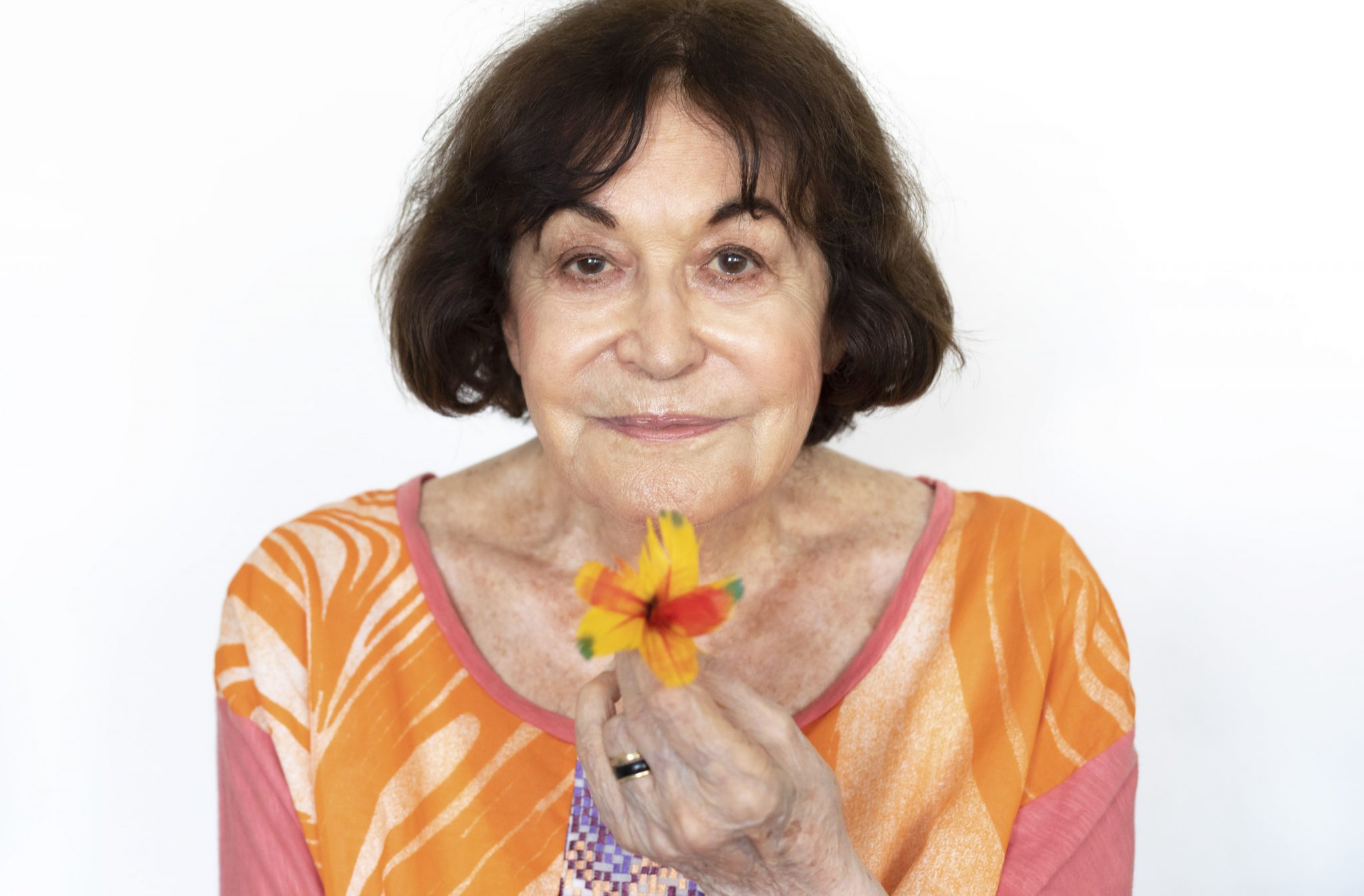By Hannah Hutchings-Georgiou
Claudia Andujar: The Yanomami Struggle is showing at the Barbican Curve until 29 August 2021. Click here for more information and to book tickets (student, NHS staff and unwaged concessions are available).

It’s raining in London, long profuse sheets of rain, the continuous kind of downpour that substitutes air for water. A few blocks from where I live, men with chainsaws and hardhats are scaling the trees, impervious to the damp, hacking at the living limbs of Planes, Sycamores and Horse Chestnuts. Whether the trees have succumbed to disease or a home owner’s desires for more light and less shadow to fall across their dining room table is unclear. What is loudly clear, however, is the rage from the electric saws, the speed with which they fell branches, slice and dice trunks, decimating what was once a complex organism into mulch within seconds. Soon the wood chippings will be dispersed along roads, distributed in parks, poured into garden flowerbeds, leaving a stump where a tree once proudly stood.
The felling of local trees may not be the most pressing environmental concern – and for some, not even a concern at all – but in the roar of chainsaws against flayed bark, I’m reminded of the control we exert over our natural world, of just how much we’re invested in the idea that it is “ours” to do whatever we want with. Though we are often subject to the, at times, catastrophic shifts of nature, we still believe we are superior to them – or at least our actions of over consumption, pollution, deforestation and colonial exploitation reveal us to feel so. In the felling of a local tree, I’m reminded of what we stand to lose because of this self-aggrandising belief. In the felling of a local tree, I’m reminded of the loss of vast swathes of woodland areas in the UK, despite legally binding commitments and pledges to do otherwise. I’m reminded of the careless destruction we wreak on non-human animals, many of whom are dependent on these habitats.
In the felling of a local tree, I’m also reminded of the illegal obliteration of tropical rainforest. Biodiverse areas such as the Amazon Rainforest are being cleared and set alight as I type this paragraph, making way for soy, beef and palm oil plantations, the products from which we, in the West, consume on a daily basis. I’m reminded of how this once biodiverse forest, a ‘sink’ for CO2emissions, is fast becoming one of the world’s main sources of it, accelerating the climate crisis into overdrive. I’m reminded of the intricate, vital ecologies that these lands, creatures and communities are part of – that we are part of; grand webs forged over years, decades, and centuries, brutally dismantled and destroyed in one fell swoop.
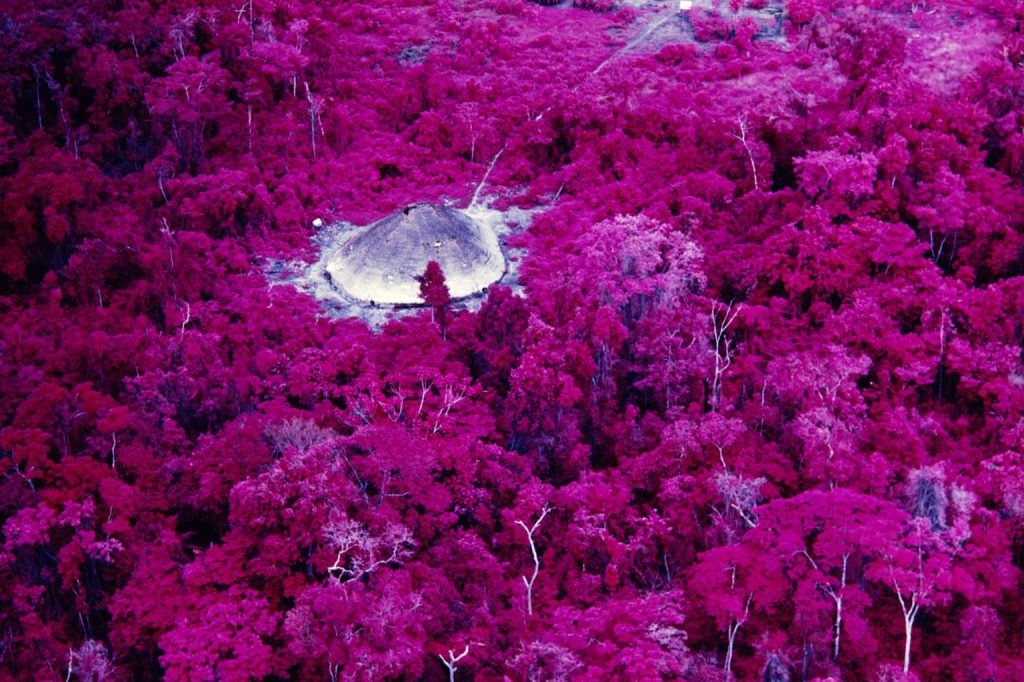
The Barbican Curve’s latest exhibition, Claudia Andujar: The Yanomami Struggle, has a different way of confronting us with the stark realities of this crisis. Rather than showing us the devastation that deforestation has on Brazil and its indigenous peoples, Andujar shows us what we stand to lose; that is, she and the Yanomami people invite us to see indigenous communities living, washing, hunting, dancing, singing, communing in and with the land. That is not to say the devastating effects of deforestation and colonial exploitation are not captured – because they are, with dedicated insight and attention. Rather, Andujar’s lens is firmly focused on the abundant life and lives found in this place – lives we imperil if we continue to close our eyes. Immersing us in Yanomami language, culture, experience and territory, Andujar’s photographs place us in the centre of their world, in the heart of the forest and its peoples. Through her unfolding relationship with the Yanomami communities, their beautiful enveloping intimacy, we cannot avert our gaze; we cannot remain coldly estranged: we must look to, connect with and embrace, albeit with respect and sensitivity, a people that must remain their own.
Immersion in Yanomami life starts with the gallery itself, which sees the outer curved wall papered with enlarged versions of Andujar’s images. Many of the original photographs hang from the ceiling in double-sided frames, encouraging us to weave in and out of the suspended imagery as if we were emplaced in the environments depicted. This technique of proximity, a disruption of the modernist white-walled curation, reanimates the viewer-viewed relationship, asking that we re-adjust our gaze and the possible preconceptions behind it. Thus we meet the photographs as if we were meeting the subjects themselves: eye to eye, face to face, palm to palm, a laying on of hands between viewer and viewed: the subtle intimacy of Andujar’s photographic touch.
Before this aesthetic embrace, Andujar moves outwards, away from human portraits to one of the land and trees. These images are breathtakingly beautiful to behold. Shot from above Roraima in Brazil, looking directly onto a Yano (a conical-shaped collective house made by and for the Yanomami community) encircled by forest, Andujar presents a portrait of a lush and mystical land, one which is central to the Yanomami’s way of life. Infrared film, a medium Andujar returns to again and again and one with political connotations, casts the proliferating canopies in a deep fuchsia light, a shade which, though seen from a distance, passionately and lavishly draws the human-made structure closer to the forest it has emerged from. The Yano therefore sits, a cherished gemstone nestled amongst pink-infused leaves; a pearlescent tree limb here, a moon-white bough there glow in sympathy with its wood-slatted roof. Andujar’s image unsettles the natural landscape through this artificial colouration and perspective; yet it’s this effect of estrangement that paradoxically draw us into sympathy with the land, accentuating its immense beauty, its innately charged character and pulsating life force. From a distance, we are pulled right in, journeying closer to the Yanomami and their forest from a height.
Another photograph mesmerises in its ability to frame the vastness of the Amazon land and skyscape. Lingering above a floating carpet of the same fuchsia foliage, parallel with a gauze of mauve and cloud-strewn atmosphere, Andujar’s eye opens to the heavens. Everything is permeated with spiritual significance; diverse colours harmoniously coalesce: again Andujar conjures something of the intimate in the sublimely infinite. And this is exactly what both these vast overviews of the Amazon allude to: the cosmogony of the Yanomami, the intersection of multiple spiritual and terrestrial planes; the overlapping of identities, existences and realities which are immanent in but higher than the organic world. As Bruce Albert relates in the exhibition catalogue, the Yanomami believe in a ‘complex socio-cosmological multiverse’, of which the earth, rivers and sky represent ‘one of four levels’ (mosi). Beyond this plane, on the other side of the sky, whose ‘distant breast is exposed to human eyes’, is a sort of celestial forest, rich with food, where ghosts of the dead feast during a special funerary ritual (a reahu). It is this ethereal forest, a cosmological canopy if you will, that Andujar’s photograph gestures to.
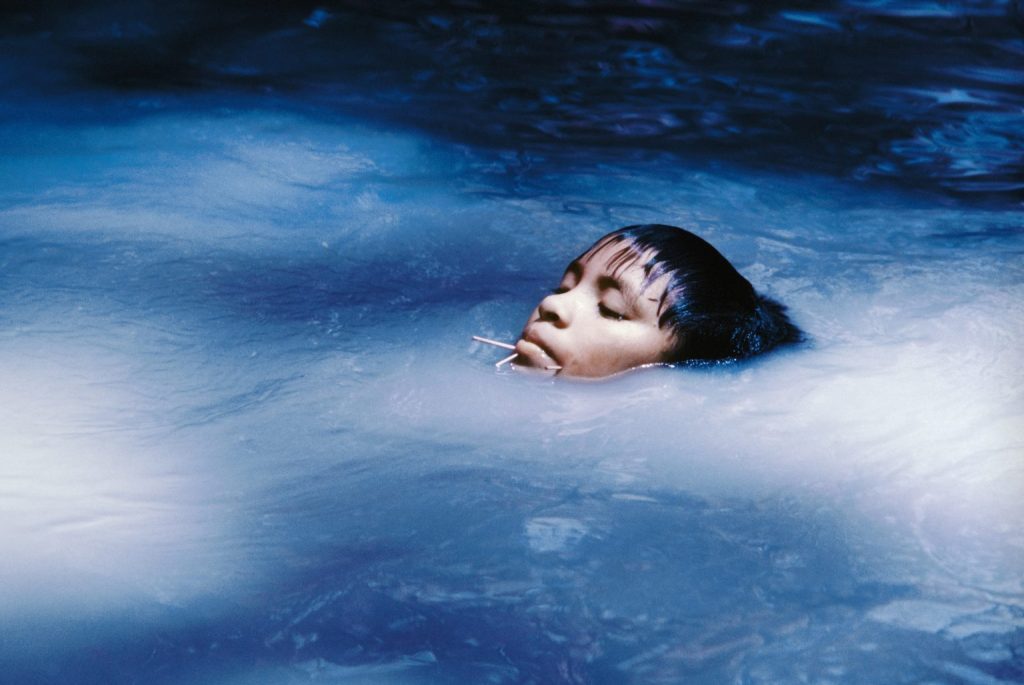
We learn then that two forests, one the shadow of its celestial other, are endangered – two forests and a multitude of living beings and spirits, human and non-human. From this eschatological height, the exhibition dives, head-first, into more earth-bound portraits of the Yanomami people themselves. Descending from the sky into the dense darkness of the rainforest, the dimly lit interior of the Yano, we come up for air in the waters of the Catrimani River. It is these portraits of young women and children bathing that I love the most, with Susi Korihana thëri swimming, Catrimani, (1972- 1974) the standout image of the whole show. A small head of a young woman – and we know she’s a young woman as opposed to a girl, boy or anyone else because her lower lip is pierced with a palm splinter, a ritual marking the beginning of puberty – lies back in the water. Is she slowly emerging from its depths or sinking beneath the surface? I cannot tell. What is certain, nonetheless, is the calm with which she occupies the water, the ease with which she floats, the sense that Susi Korihana thëri and the river are one. There is an oneiric quality to Andujar’s photographs, one that doesn’t so much romanticize the Yanomami and their land as make it hard to distinguish where this palpable principle of vitality begins and ends. This is true of Susi Korihana thëri swimming, Catrimanitoo, where light, liquid and skin are in seamless agreement, each element embodying, rippling into, the other, as transposed onto the infrared film. Light flows to liquid cerulean; the river effervesces into waves of milky blue; a girl, simply bathing, swimming or both, is transformed and transforms our notion of what it is to be in and of a particular place and time.
Standing with my dear friend M, whose imagination is as magical as the Yanomami’s cosmological conception of the land, we were both in awe of the water series. M’s sublime stories, awash with sea goddesses, floods and cascading multiverses aplenty, share parallels with the nature-inspired mythos of indigenous peoples, the fiery eyes of Shamans, the ever-opening lens of Andujar. Though of different cultural backgrounds, M’s mind and the fertile mythology of the Yanomami spring from and towards a mutual reverence for the natural world they and their ancestors inhabit, an appreciation of the possibilities that lie within its depths, underneath its green-blue tender skin. When reading one of the few sporadically placed wall cards – another curatorial choice marvelously disruptive of the staid white-walled gallery encounter – M and I learnt that the Yanomami ‘trace their origin to the copulation of the demiurge Omama with the daughter of the aquatic monster Tëpërësiki, the ruler of cultivated plants’. Even here, water and earth intermix, their spiritual counterparts overflowing and generating into generation upon generation of Yanomami peoples. To lose the land that this and other indigenous Amerindian communities have nurtured and existed in for centuries, is to lose this rich seam of thought, more precious than the gold that lines the river’s soil; this symbiotic way of living and seeing and being. More importantly, it is to lose the people themselves – to turn them, not just their culture and language, into myths and legends, rather than the dynamic, living community they are.
Delving deeper into Yanomami life, we enter the Yano, the communal space at the heart of each village. Here brush and forest trees have been erected in a clearing and turned into a conical cathedral-like structure, one where the complex scaffold of timber now uphold row upon row of wooden slats. Light breaks through its tightly knitted frame, the palpable heat of the outside always present, even in the shade of this new domestic forest. Andujar’s photographs cast this home within a home in ghostly black and white film. Yanomami men and women are seen tending fires, stirring pots, sleeping in hammocks, their children ever aware of Andujar’s lens. Little faces appear from the shadows, curious of the camera and the woman behind it. Light spills illuminating bodies, apparitions of former selves; a child glows, pellucent against the growing darkness. Outside the Yano, the forest waits, oblivious to the ghostly forms dwelling within.
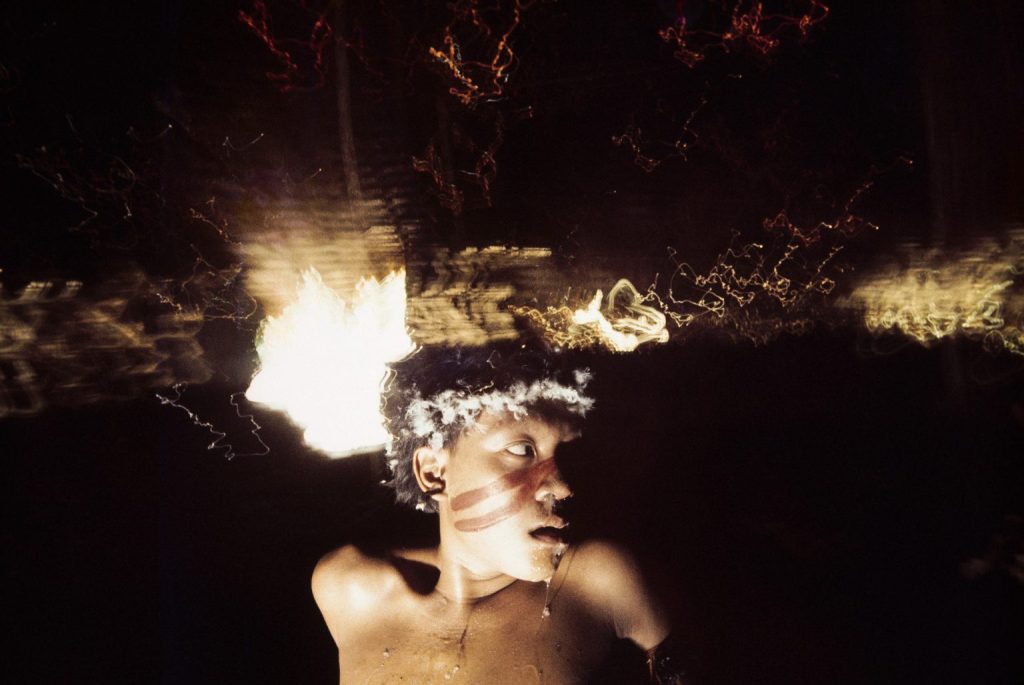
Andujar’s apparitional representation of the Yano sets us up for the equally spectral rendering of the reahu, a funerary ritual and intercommunity gathering. At the reahu, Yanomami sing, chant and dance, while their shamans inhale a hallucinogenic powder called Yãkoana, so as to commune with and nourish Xapiri. These miniscule spirits or ‘miniature men’, who are adorned with down and play and dance on ‘mirrors’ (spiritual reflective surfaces) in the forest, are considered multitudinous (never a singular essence). Andujar situates her images in this sense of the infinite, again, by replicating the bodies of Yanomami men and women, so that they are corporeal echoes of each other, limitless transfigurations, radiant glimmers of man that fade in and out of a collective spiritual consciousness. Andujar’s films, which set these transposed images to an accompaniment of sounds and songs, further this ecstatic state and awakening. The reahu subsequently banishes binaries of grief and joy, body and soul, collective and individual, merging them all in a close-to-death, elative experience for shamans and the Yanomami people.
Looking back on this part of Andujar’s archive, the hallucinatory quality of the images takes on a different light. The reahu, though electrically alive in Andujar’s photographs, becomes a fleeting and rare occurrence; a super moon in a black night sky. Dated from the early-to-late 70s, these photographs capture a way of life seemingly unspoilt by the threat of illegal deforestation and gold mining, and the Perimetral Norte (Transamazonian) Highway, the formation of which saw migrant workers bring disease and violent attacks on the Yanomami communities. Standing in the gallery, struck by the powerfully unified spirit of the Yanomami people, I couldn’t ignore the fact that in this burst of vibrantly full living, the reahu series could easily be perceived as a wider form of collective grief for all that hung in the balance; for an evanescent world as the Yanomami knew and saw it then. Some of the people in these blazingly vivid portraits are no longer alive because of colonial exploitation by non-indigenous individuals, political bodies and corporations. But in the dazzling firelight, in the flare of seeing other spirits dance down from the horizon, beyond the verdant trees, in the movement and chants of the abandoned, Yanomami defiance is also present. The reahu series is neither swansong nor victor’s anthem for the Yanomami people’s struggle, but a clarion call for us to look, listen, learn and act in support of it.
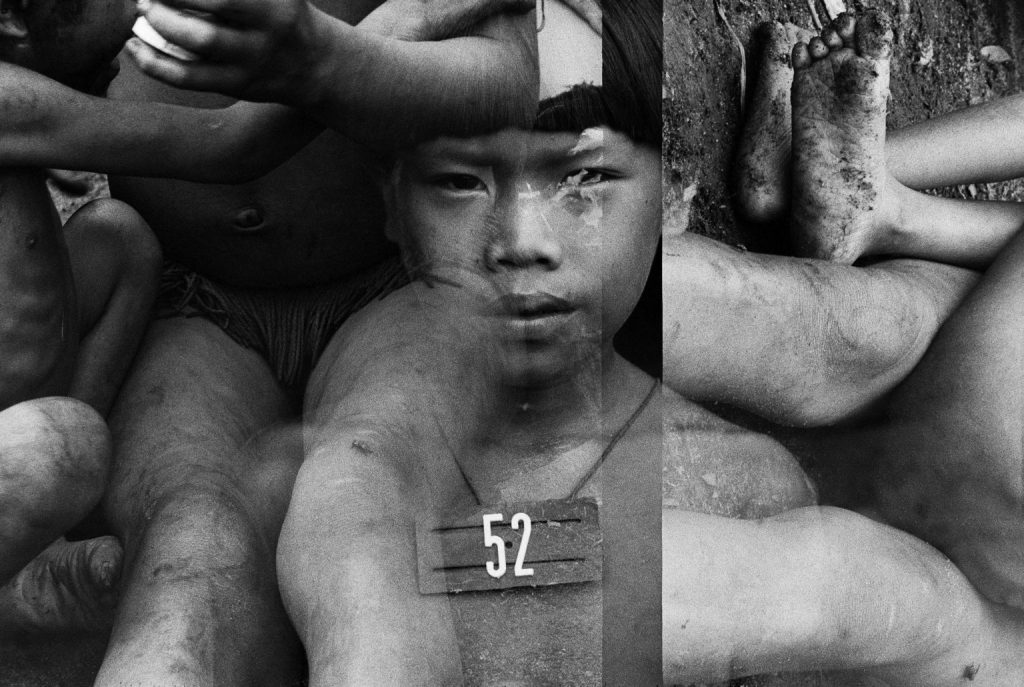
Eyes look out from the brush of the forest; a nose, lips, the strong shoulders and arms of youth. Trees I cannot name shoot up from his chest – the Kapok, the Palm, the Brazil-nut – bark for skin, leaves of feeling, wild grasses and plants where hair should be. This image should be pure poetry, a visual ode to the culture of the Yanomami, were it not for the identification tag around the young man’s neck, a symbol that is all not well for the land and its people. The final images of the exhibition are portraits of Yanomami individuals after having been vaccinated, the only photographs purposed to record and monitor: to see and be seen in a classificatory light. But even here, the later series is transposed onto earlier images of leafy, tree-filled terrain, aerial views and shots of treks. Combining portrait with landscape visions, remote past with the more recent present, the exhibition comes full circle, embedding the land in the people and a people in, what has been officially declared, their land. But these exquisitely haunting portraits must not become that: spectres on the conscience of a world that willingly ignores the felling, burning and ravaging of an ancient forest, the killing of its peoples and their histories, the death of a future. Rising up from the earth their ancestors came from, the Yanomami survive, but the struggle continues.
*
To find out more and learn how you can support the Yanomami, please visit www.hutukara.org or www.survivalinternational.org/tribes/yanomami
